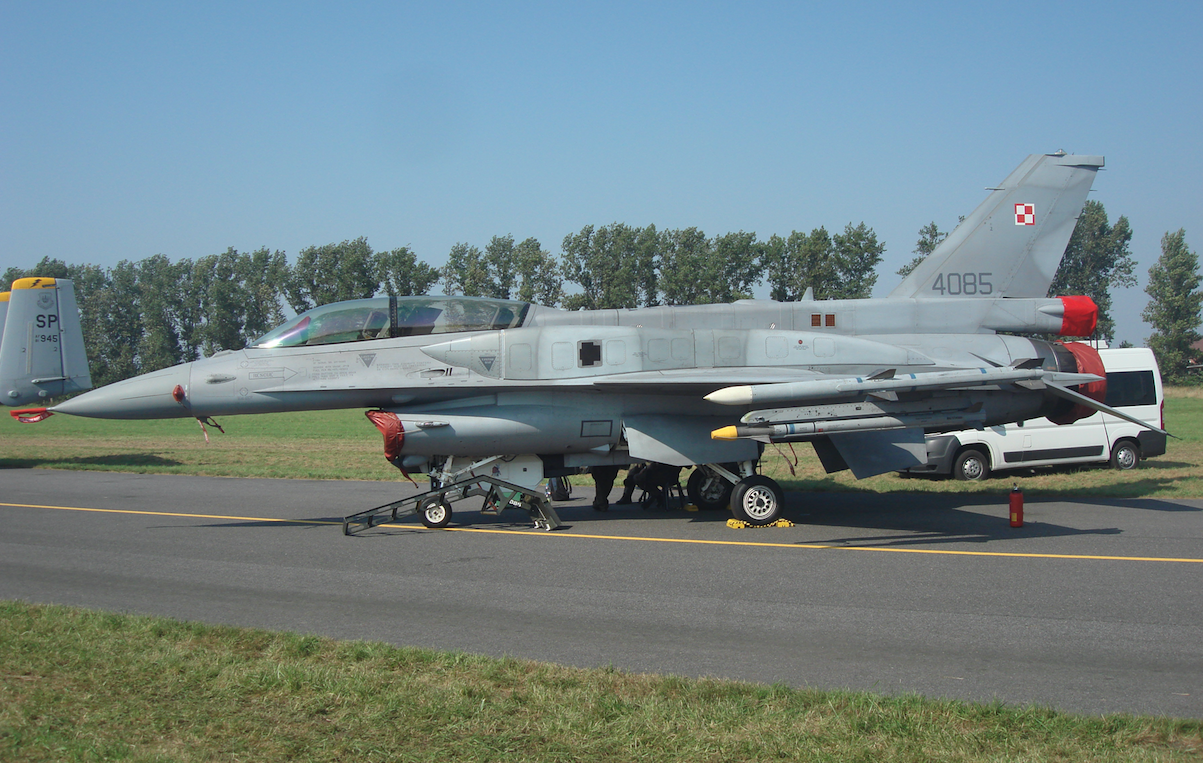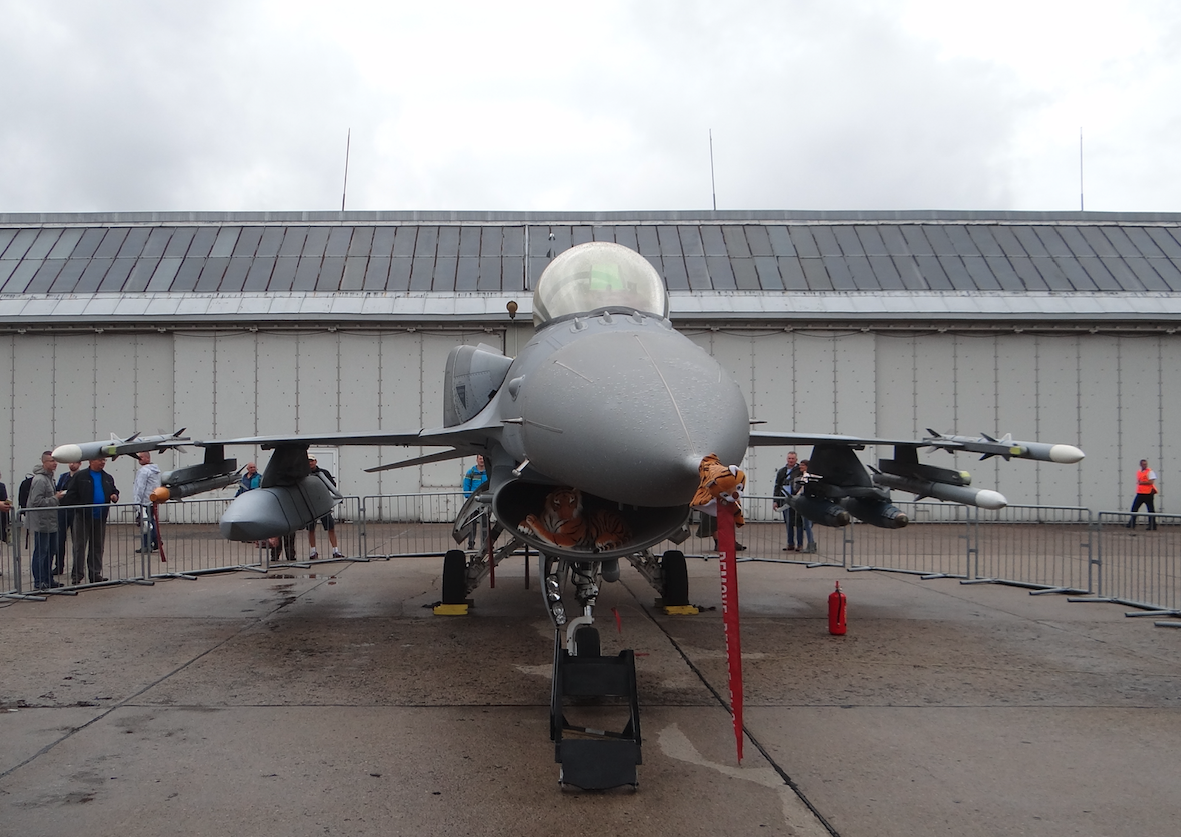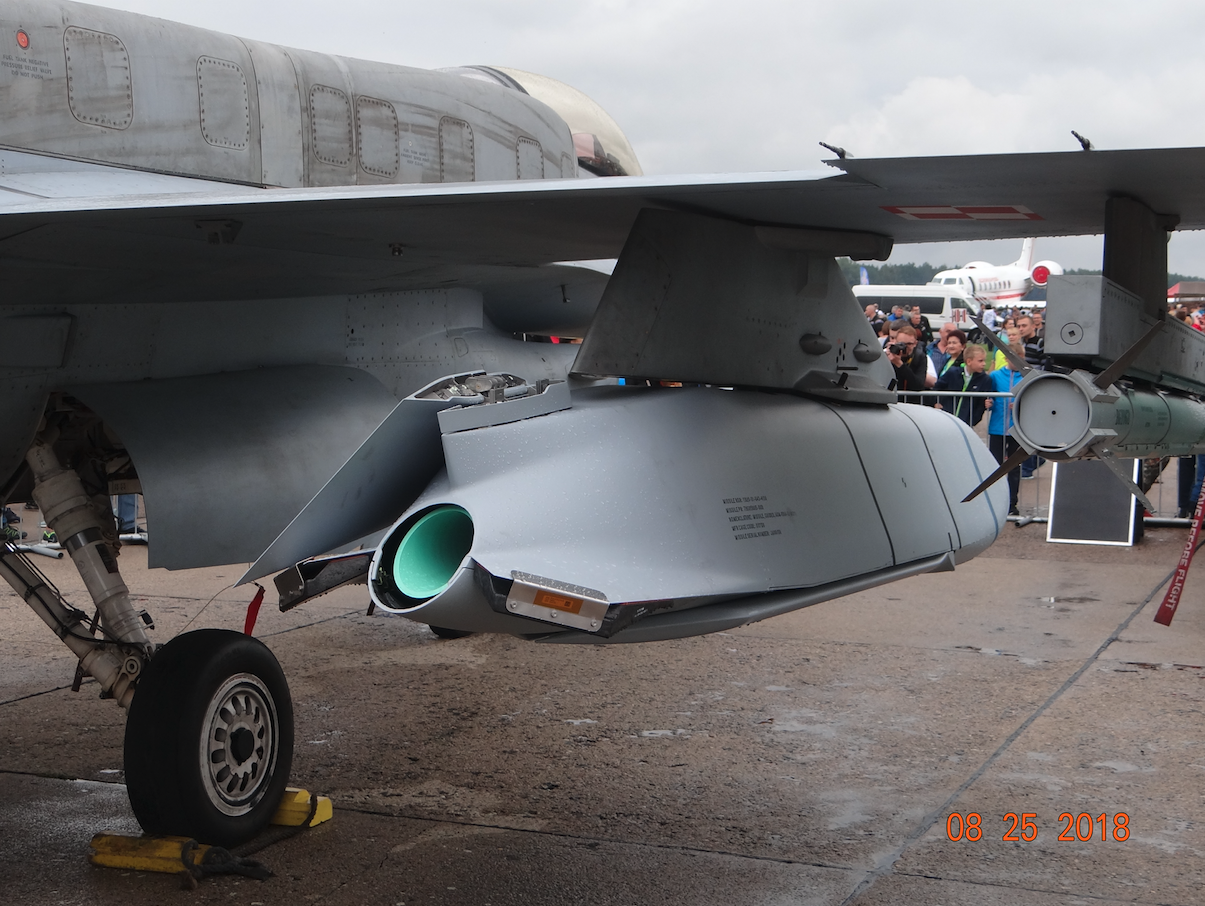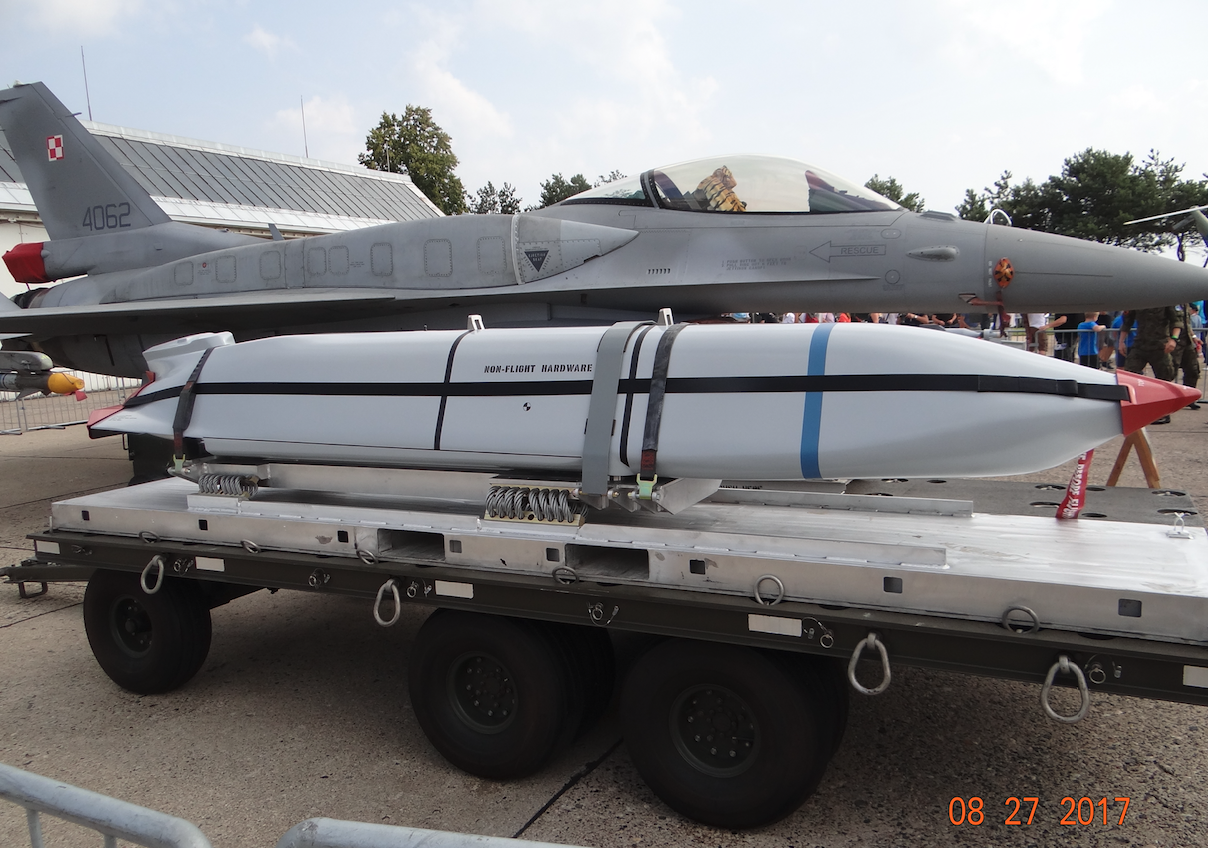Kraków 2017-08-26
Lockheed Martin (General Dynamics) F-16 D Advanced Block 52 + Jastrząb.
315 Section 2006-11-08. Poland.
History F-16 in Poland.





Under the wing of the AMG-158 JASSM, a Joint Air-to-Sur face Stand off Missile with a range of 370 km.

History of Polish F-16s.
Since 2006, the Polish Air Force has been operating multi-role combat aircraft (WSB) Lockheed Martin (General Dynamics) F-16 Advanced Block 52 + Jastrząb. Emotions about buying them have already subsided. The machines work very well. The National Catholic Government of the Republic of Poland has already sent these planes on stabilization missions to the Baltic States and to Iraq in the Middle East. In this way, it was possible for Polish combat units to gain valuable experience in real combat conditions.
Originally, Poland was to purchase 60 combat aircraft, which were to be delivered to Krzesiny (3rd ELT - tactical air squadron), Łask (10th ELT) and Powidz (6th ELT). Due to the acquisition of further used MiG-29 machines from the raid, the number of new WSBs was reduced to 48 (36 single-seaters and 12 two-seaters). By choosing the F-16 aircraft, Poland decided to become involved with American defense technology for many years, which is a good choice and promises to acquire modern F-35 fighters in the future. The highest authorities of the Republic of Poland decided that the main base of the WSB F-16 was the unit located at the airport in Krzesiny. This airport has been used by military aircraft for over 90 years. The Krzesiny airport has become a modern base that meets the standards and procedures for the operation of WSB. 32 machines are based at the Krzesiny Airport (31st Tactical Air Base). The second base is Łask Airport (32nd Tactical Air Base), which has also been completely expanded. 16 machines are based here, including all of them with reconnaissance tasks (the DB-110 tactical air reconnaissance system by Goodrich).
History of the F-16.
At the end of the 60s of the twentieth century, the USAF air force based the concept of aviation on a heavy fighter aircraft (implemented in the form of the F-15 aircraft) and a light one, which was to be its complement. The competition was designated LWF (Light Weight Fighter). On February 18, 1972, five companies were invited to the next stage of the competition: General Dynamics, Northrop, Boeing, Lockheed, LTV Aerospace. The companies were to present detailed drafts of their proposals. The following companies went to the next stage: General Dynamics and Northrop. On April 14, contracts were signed with both companies for the construction of two prototypes, which were designated YF-16 and YF-17.
The General Dynamics company developed its project marked Model 401. It was supposed to be a light aircraft with the lowest possible take-off weight, single-engine, with excellent aerodynamics and controllability. The first flight of the prototype was to take place 22 months after the start of work. In order to shorten the time of work, the constructors took many ready-made and proven solutions "off the shelf". The construction of the mock-up and the airframe for static tests was abandoned, which was madness, but testified to the great experience of the constructors.
The first YF-16 flew on February 2, 1974, and the second on May 9, 1974. The first prototype of the YF-16 already on March 11, 1974 reached the speed of Ma-2, at a ceiling of 12,100 m. Comparative tests of the YF-16 with the YF-17 were completed in January 1975 and it was decided to mass-produce the General Dynamics F-16 aircraft.
The competitor, the Northrop YF-17, developed a twin-engine aircraft, which admittedly lost to the YF-16, but gained the interest of the US NAVY and realized itself in the form of an excellent F-18 fighter.
On April 9, 1975, General Dynamics entered into a contract for the production of 6 F-16A single-seaters and 2 F-16B two-seaters. These aircraft were defined as pre-series. The USAF planned to purchase 1,388 F-16 machines. The first F-16A flew on December 8, 1976. The first F-16B flew on August 8, 1977. Serial production started in 1978. Foreign orders arrived quickly.
In 1975, European NATO countries were looking for a replacement for the Lockheed F-104. The following aircraft entered the competition for a lucrative contract: Mirage F.1E, SAAB Viggen-37 and F-16. The advantage of the F-16 aircraft over competitors turned out to be very large. Only he had an electronic control system and had the largest range of weapons. The initial order for Western Europe was for 348 F-16 A/B aircraft. The combat capabilities of the aircraft were extended by installing a modern radar station. The front part of the fuselage was rebuilt by widening it. The program of the aircraft was expanded to include the possibility of carrying nuclear weapons. Licensed production has been launched in Europe. The unit price of the F-16A aircraft in 1980 was about $ 6.7 - 8 million.
In the 80s of the twentieth century, new versions of the F-16 C / D were introduced into serial production, with one and two seats, respectively. More important, however, are the terms Block, which represent individual, higher levels of aircraft equipment, and at the same time combat capabilities. Block 10, 20, 30, 40 and 50 were created in succession. Additionally, the second digit, 0 or 2, denotes General Electric or Pratt & Whitney engines. In 1993, serial production of the F-16 aircraft was transferred to Lockheed Corporation, to which General Dynamics' aerospace production division was sold. In 1995, Lockheed merged with Martin Marietta, creating the Lockheed Martin concern, which became the manufacturer of the F-16, including all copies that went to Poland. By 2012, approximately 4,500 F-16s had been built. F-16 aircraft are used in 26 countries.
Despite the more than 40 years that have passed since the F-16 flew, the USAF intends to operate them for another twenty years. In other countries it will be longer. In the USA, new versions of the F-16 are not being developed and production is already being phased out. The successor to the F-35 is already on offer.
Lockheed Martin is headquartered in the suburbs of Washington, D.C., in Bethesda, Maryland. Lockheed Martin employs about 130,000 employees in the USA and around the world. In 2005, the company supplied customers with equipment worth a total of 37 billion 200 million dollars. The planes are built at a factory in Fort Worth, Texas.
F-16 ready for Poland. September 16, 2006.
During the official visit of Polish Prime Minister Jarosław Kaczyński to the USA, the first Polish F-16 aircraft was officially demonstrated. “Freedom must be secure, freedom must be defended; in order to do that, you have to really cooperate. ... This aircraft is not only modern, but also beautiful. ... Today is a successful day." - said on Friday (September 16, 2006) Prime Minister Jarosław Kaczyński at the Fort Worth Texas military base, where the ceremonial presentation of the capabilities of the F-16 aircraft took place.
What is the F-16 plane?
The F-16 multi-role aircraft is in service with the armed forces of 26 countries. Poland became the 24th country. There are two new countries after us. About 4,500 of these machines have been produced so far. They spent a total of over 14 million hours in the air. 26 countries have ordered F-16s for a reason. It is a proven and so far reliable machine. Over 70 victories in air combat without own losses is an absolute record. The F-16s only fell to the ground after being knocked down by a surface-to-air missile or after running out of fuel. Experience in over 100,000 combat missions are the best references of the F-16. It was on its first versions (F-16 A/B) and on the F-15 in the Bekaa Valley in 1982 that Israeli pilots fought with the Syrians on the MiG-21 and MiG-23 one of the largest air battles of the Cold War. In one day, in several engagements, they shot down about 90 Soviet aircraft, without losing any! But the real baptism of fire of the Israeli Falcons was a year earlier. On Sunday, July 7, 1981, from the base on the Sinai Peninsula (then occupied by Israel) at At 12:55 Greenwich Time, eight Israeli F-16s and two F-15s took off. They moved east, towards the Osirak nuclear reactor near Baghdad, which was being built by Saddam Hussein. Entering Iraqi airspace, they descended to a height of only 30 m to avoid being detected by SR. At. At 17:35, 20 km from the target, the Falcons climbed to a height of 2,130 m and dived back towards the reactor. Each aircraft dropped two 1,000-kilogram bombs. They all hit the target, and Saddam's atomic dreams were nipped in the bud. The rapid escape to the altitude of 12,000 meters did not give the Iraqi anti-aircraft defense a chance. Even before dusk, all the Falcons, with a distance of 2,000 km behind them, returned to the base. – “None of us expected that all planes would return to the base. In the meantime, we all landed without even a single scratch" - says Col. Zeev Raz, one of the participants of this flight, years later. Another pilot, Col. Ilan Ramon, survived the Osirak raid, only to die 22 years later over Texas in the Columbia space shuttle disaster.
Falcons also served as "workhorses" during Operation Desert Storm against Iraq in 1991. During the Gulf War, they made 13.5 thousand. combat missions. They took part in the invasion of Iraq in 2003. They were also used in peacekeeping operations in the Balkans. In July 2006, two F-16s appeared in the sky over Iraqi Bakuba. They flew over one of the buildings and dropped two laser-controlled, five-hundred-pound bombs on it. The bombs completely destroyed the house where Abu Musab al-Zarqawi, the leader of al-Qaeda in Iraq, was hiding.
Compared to other fighter aircraft, the F-16 is distinguished by its acceleration and maneuverability. During the Gulf War, one of the F-16 pilots managed to escape six surface-to-air missiles fired almost one after the other. The F-16's advanced electronics allow it to fight other planes from a long distance. After adding several types of missiles to the standard cannon, the pilot (thanks to information from the radar with a range of over 100 km) can hit the enemy from a distance of several dozen kilometers. Refueling in the air allows it to fly for many hours.
Malicious people say that Poland bought an outdated structure from 30 years ago. "But it's just like with cars. The type seems to remain the same, but what lies dormant under the hood of subsequent models makes a fundamental difference,” noted Colonel Wojciech Krupa, commander of the 31st Air Base in Krzesiny.
Above, we mentioned the successor of the F-16, the F-35. However, the F-35A aircraft has a serious drawback: it is very, very expensive. For example, Israel purchased 14 F-35As with a training and maintenance package for $2.8 billion. According to the catalog, one F-35 A aircraft costs $ 110 million, which is three times more than the F-16 C. Already 10 years ago, second-hand F-16s were to be purchased in Poland to replace the Su-22 and MiG-29 aircraft. But that didn't happen. So if you decide to buy new F-35 A, the purchase cost would be much, much higher. With the purchase of F-35 A aircraft for three Squadrons (Mińsk Mazowiecki, Malbork, Świdwin), we should purchase 48 F-35 A aircraft. The contract would amount to $ 5.0-6.5 billion. These are only estimates. However, if you opted for the new F-16, the price would be around $3 billion, and significant other costs have already been incurred. We have already built a logistics and training system. However, the assembly line at the Fort Worth plant may be closed in 2018. Then the option to buy used machines and bring them to the Block 52+ standard will remain. The cost of such an aircraft would be around $30 million.
F-16 vs. MiG-29.
F-16 and MiG-29 are two flagship productions of two superpowers on opposite sides of the Iron Curtain. Let's compare:
The F-16 has one engine (the MiG-29 has two), it is smaller (15 m long), lighter, generally more maneuverable and more versatile. It has a longer range (up to 3,900 km), can refuel in the air and takes a larger payload. It also has better visibility from the cockpit than from the cockpit of the MiG-29. Unlike his Soviet colleague, the F-16 pilot can calmly see if anyone is on his tail. The hawk is also super-convenient to use for the pilot. But the Soviet machine (17.3 m long) designed more to protect troops and facilities in its own "backyard" than to perform distant missions, has its advantages. The Yankee pilots, who switched to the MiG-29 during joint exercises with the Germans in Sardinia in 1995, were shocked by their maneuverability at lower speeds. They also paid attention to the power, the air-to-air missile thermal guidance system and the possibility of using the targeting system mounted in the pilot's helmet. The MiG-29, unlike the F-16, does not require a flat runway and can land at field airports. And the disadvantages? Poor ergonomics and complicated apparatus. - "You must be an octopus to handle all this" - summed up one of the USAF pilots. Which aircraft would win in head-to-head combat? The skill of the pilots would probably decide. The problem, however, is that before the MiG-29 detects the approaching F-16 Jastrząb, it has already fired a missile.
The "sensational" conclusions were reached by the Masonic-liberal media, which compared the F-16 aircraft with the MiG-29. They reported that the maximum speed of the F-16C/D is 1,460 km/h. (1.2 Ma) at sea level and 2,175 km/h. (2.05 Ma) at an altitude of 12 thousand. meters. The practical ceiling is just over 15,000. meters. The range with a typical combat load is 1,000 km, and the range for ferrying is nearly 4,000 km. kilometers. The F-16C/D block 52 is powered by a Pratt and Whitney F-100-PW-229 turbofan engine with a thrust of 130 kN with afterburning. The maximum take-off weight of the aircraft is close to 17,000 kg. The MiG-29, on the other hand, has a V max of 2,445 km/h (so it is "much faster" by 270 km/h than the F-16). It has a ceiling of 17,000 m (2 km higher than the F-16), the combat range is 1,150 km (150 km further than the F-16). The MIG-29 has two engines (so it is more reliable, because the failure of one engine does not force the pilot to catapult immediately), each with a thrust of 8,300 kG (18,300 lb) or 81 kN (together 162 kN, which is about 25% more than F-16). The take-off weight of the MiG-29 is 18,000 kg. Thus, the performance of the F-16 is worse than the MiG-29. Application? It is better to buy MiG-29 aircraft. We suggest freemasons and liberals not to buy Renault cars, but Lada cars, because they are certainly better. They have thicker sheet metal and have a longer range, with canisters in the trunk.
Lockheed Martin F-16D - two-seater.
When the General Dynamics F-16 aircraft was being created, it was still a standard to develop single-seat machines supported by two-seater training-combat versions. However, unlike the MiG-29 UB aircraft, the F-16 B/D aircraft have the same combat capabilities as the single-seat versions. This happened because the F-16 B/D was not deprived of the radar station. General Dynamics could afford such a luxury, because the mass of on-board equipment was not that significant. It is in this fact that the key to the superiority of the US technology over the technology from the Moscow state lies. The Polish Lockheed F-16 D Block 52+ Jastrząb aircraft have the same combat capability as the Lockheed F-16 C Block 52+ Jastrząb. Some of the equipment that did not fit in the fuselage (due to the additional space for the co-pilot) was placed in the superstructure on the fuselage of the aircraft.
Data T-T F-16 C/D Block 52+:
Span 9.45 m. Length 15.03 m. Height 5.09 m. Wing bearing area 27.90 m2. Curb weight 8,870 kg. Maximum weight 19,185 kg. Cargo weight 5,435 kg. Fuel 2,570 kg, 3,935 liters. Maximum speed 2.2 Ma. Top speed 2,700 km/h. Maximum speed 1,472 km/h at 0 m altitude. Climb speed 230 m/s. Range 4,472 km. Combat action radius 500 - 980 km. Ceiling 15,250 m. Take-off run 530 m. Landing run 800 m.
Written by Karol Placha Hetman
